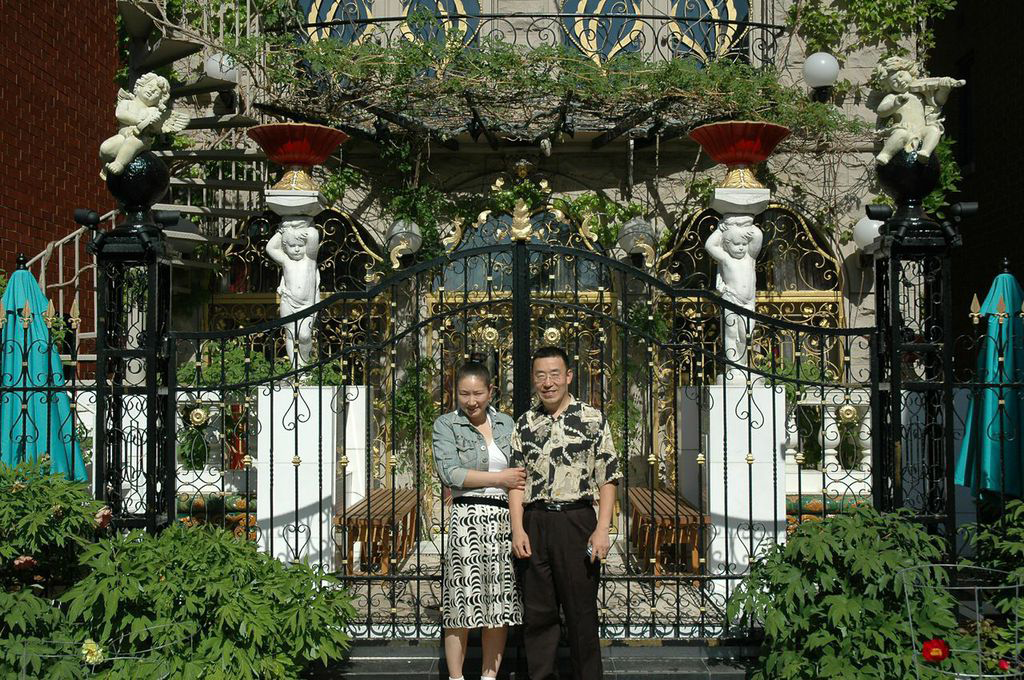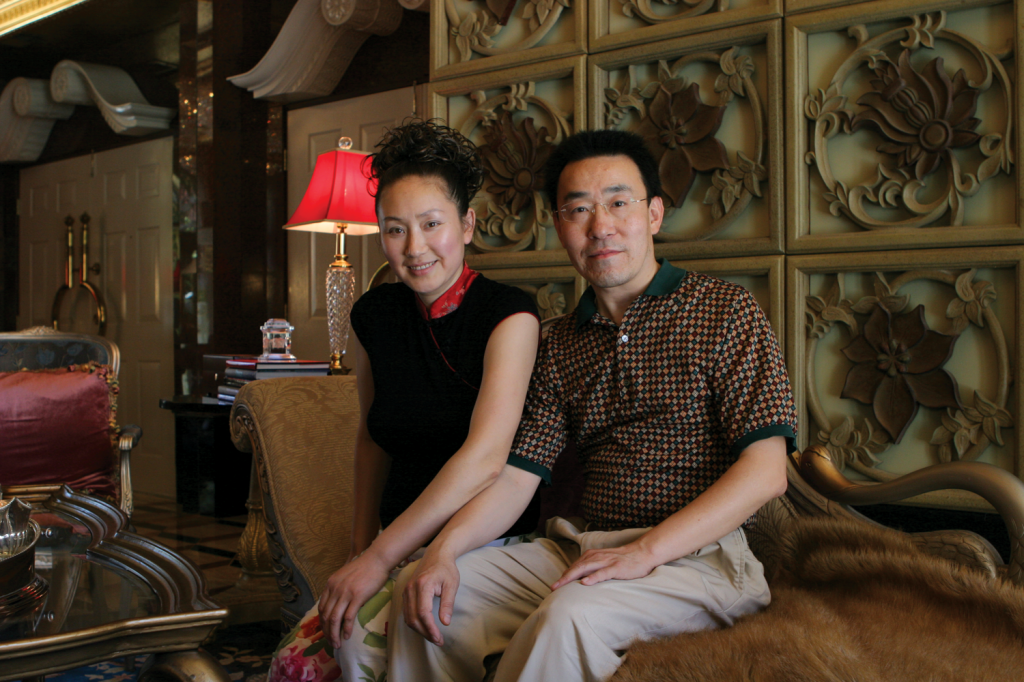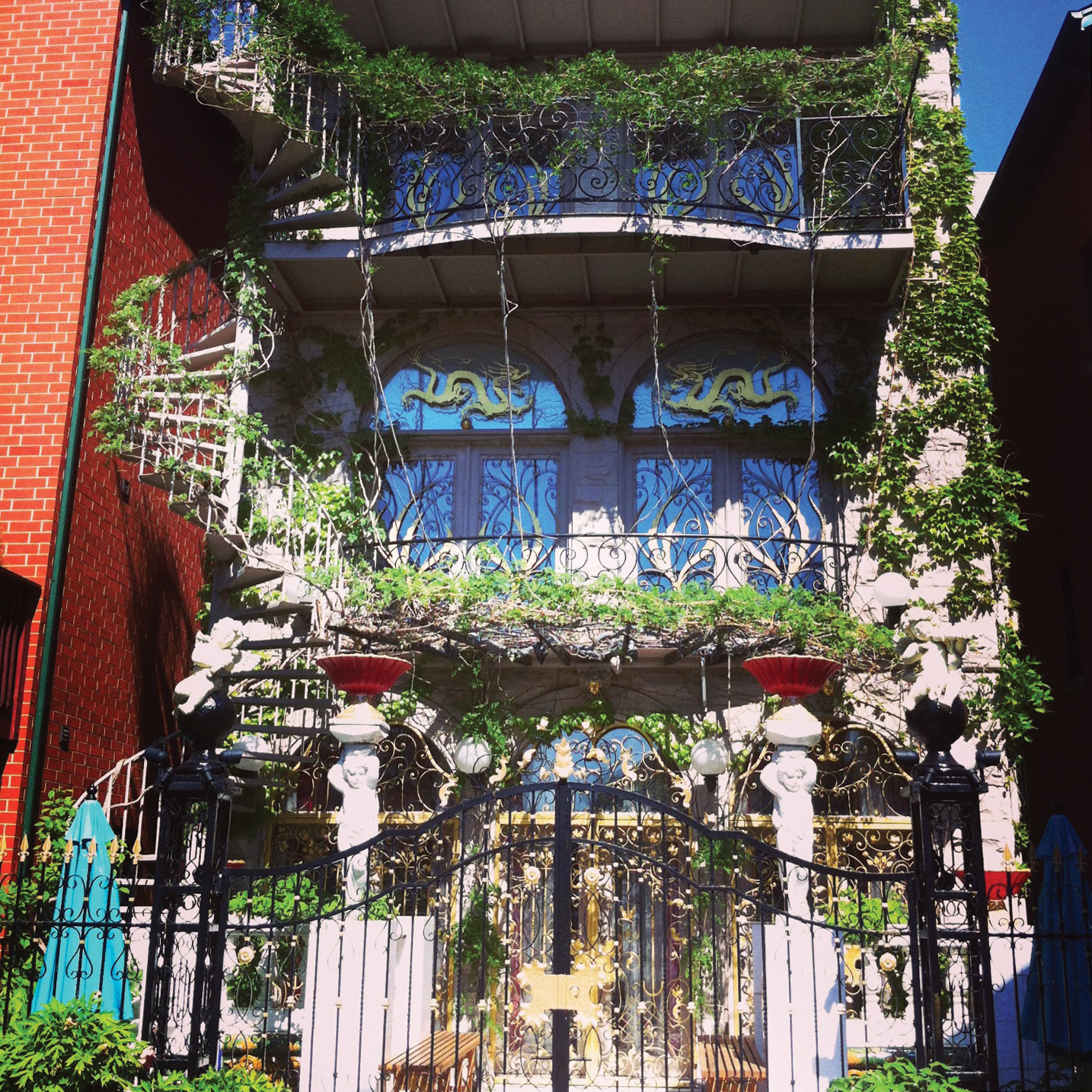
Chinatown’s South Louie Parkway—just one block long, located squarely between Ping Tom Memorial Park and the Chinatown Square shopping district—is, for the most part, a quiet residential street. The rows of plain brick homes, built by the Richland Realty Group in 2002 as affordable housing for workers and recent immigrants, sit at the lot lines of the narrow road, lending it the feel of a suburban alley.
Among these houses, there is only one that attracts attention, what with the tangles of ivy that cover its white stone facade and cascade down its balconies and spiral staircases. Several chubby putti overlook the house’s regal gate, guarding the garden of Chinese trumpet flowers, tree peonies, and wisteria, while gilded dragons adorn the home’s large upper-story windows.
The house is a labor of love created by first-generation immigrant and mortgage-broker Charlie Gu, who, along with his wife Sandy, has dedicated years to crafting his ideal home. To some, the house—which includes a personal home theater, an “Arabian-style” master bedroom, a ping-pong room, and a tiny kitchen hidden behind a mirrored glass wall—may seem excessive and opulent. But if you spend any time talking to Gu, it becomes clear that that the home’s grandeur is born in large part from a keen sense of thrift.
The art on the walls alternates between lush oil paintings of American forests and European-style impressionistic water scenes, and was all purchased on the cheap from HomeGoods, a T.J. Maxx subsidiary—with the exception of several Chinese-style silk paintings, whose price Gu cites as $1.50 a piece in China. The dark red drapery lining the walls of the master bedroom is, he reveals, no more than repurposed tablecloths from Target.
Other aspects of the house are designed with function in mind, but form is not forgotten. The clandestine kitchen, where Gu often finds himself cooking for guests, is hidden away behind mirrors due to his preference for Chinese stir-fry. The dish, he says, creates too much smoke to cook comfortably in the presence of visitors.
There’s no denying that a large part of the home’s design is purely aesthetic. Gu says that his eye for detail and design developed from his early interest in art. “When I was in China” he says, “before I went to college, I [was] painting every day, dreaming of being an artist. But in China, at that time, too many people were waiting to go to art school. They took probably one in one hundred people. It was so hard to be an art student then because China has too many people. So I changed my major to finance when I went to college.”
After finishing his studies in China, Gu moved the U.S. with the dream of designing his own home. He wanted a space larger than the 1,000-square-foot condo he grew up in in Beijing, one where he would have the opportunity to exercise his own aesthetic preferences. After first moving to Los Angeles, a city he disliked due to the heat, Gu decided to move to Chicago. He bought a sixty-four dollar Greyhound bus ticket and embarked on the forty-eight-hour journey.
Though he wanted to live in Chinatown to be close to familiar culture and food, he was initially unable to afford living there. He instead moved to the more affordable, nearby Bridgeport. While living there, he worked a number of odd jobs, including making fake jewelry, before eventually breaking into the mortgage business. Though he was grateful for the work, the entry-level job didn’t pay much. Still, Gu was not dissuaded.

His big break came through a connection he made while he was working in the mortgage department at the Richland Group. The development group, which has worked in Chinatown since the late 1980s, was completing construction on the Santa Fe Gardens, a development of affordable single-family houses on what was then vacant land owned by the Santa Fe Railway. Gu was looking to move to Chinatown—but he wanted his house to be constructed according to his own design.
“The builder is a friend of mine, so I said I would just change the design a little bit,” Gu says. “But actually I changed the blueprint floor by floor: windows, doors, the height, everything.” Gu gathered materials on the cheap from China, and this cost-cutting strategy wound up influencing the style of the house.
“In China, they like the European style: more glamour, you know. America, now, likes more country style—wood color, a more natural look,” Gu explains. “But the Chinese really like the European royal style, with lots of gold plating and stuff like that. So I purchased gold moldings, marble, and so on.”
Now the president of his own company, Leading Mortgage (located in Schaumburg), Gu still has a sense of humor about the humble origins of many of his materials. He’s quick to point out which items he purchased at discount stores or constructed himself. Far from cheapening his work, these more modest pieces serve to show how skilled Gu is as a designer; with the deliberate placement of each object—and the anchoring effect of a few showcase items like Chinese-imported crystal chandeliers and Victorian-style couches—Gu is able to create a sense of pristine luxury by context.
The house has been mistaken for a temple, an easy mistake given the gilded dragons and carefully arranged flowers. “One time I was doing decoration in the back,” Gu says, “and a man comes up to me and says, ‘Is this a place of worship?’ I asked him, ‘What do you mean?’ Because this is a new word for me: worship. He was surprised that I didn’t know the word. Then he explained, ‘Worship…it is the place to please God.’ I said, ‘Oh, now I understand! But no, this is a place to please myself.’ ”
As we speak, several family groups pass by the home. Some stop and gawk, others take pictures.
“Sometimes people are curious about who lives here,” he says. “So I tell them, ‘Seriously, Tom Cruise lives here.’ And they go ‘Really!?’ A lot of times people think this is a restaurant, and ask, ‘Why is this restaurant never open?’ ”
Yet Gu says that few people ever ask about the house’s story.
“The Chicago Tribune, a few years ago I think, came by and took pictures, but they said, ‘Hey, these are amazing condos!’ They didn’t think it could just be a single family home.
“Nobody knows the story of the house—except for my neighbors—because no one ever asks to come inside,” Gu adds. “They only see the outside.”


